3.5: The Sami‘a of Salalah: Sheikh Ahmad and the Jalsa at-Tara
AKR in Oman Part 3
3.5: The Sami‘a of Salalah: Sheikh Ahmad and the Jalsa at-Tarab
There is a saying in Arabic: “A chance meeting is worth a thousand appointments” (sudfa ghair min alf mu‘ad). I have been practicing this phrase in Arabic for 17 years since my colleague and friend, Dwight Reynolds, exclaimed it to me at a conference where we bumped into each other by surprise. In my life the phrase often rings true and I have learned that the “chance meeting” an essential element of fieldwork. My chance meeting with Ahmad Bin Suwaidan Al Balushi has led me into a world of music connoisseurship that I yet to experience in the Sultanate and has given me yet another perspective on the relationship between patrons and musicians in Oman. My experiences in Sheikh Ahmad’s music world have also helped me to see and hear the area of Southern Oman and Yemen as a musical region.
Here’s how we met:
I changed my plane ticket from Muscat to Salalah so I could see the performance of the Al Majd ensemble, before the group and its director, Rageb Khamis, left on a tour to Zanzibar for ten days. Because of the cool and rainy Khareef season, the flights from Muscat to Salalah were packed but I managed to find one seat in business class that would get me to Salalah just in time to make it to the festival grounds for Al Majd’s performance. I paid for the ticket change and the upgrade: opportunity cost. When I boarded the plane the gentleman seated in the front row asked if I would change seats with his friend so they could sit together. But after he saw me stowing my ‘ud in the overhead compartment he must have changed his mind. Following take off the man turned around and started talking to me through crack between our rows. A few minutes later he invited me back to my original seat so that we could chat.
Ahmad bin Suwaidan Al Balushi is former Minister of Communication 1984-2000, a post he was appointed to by Sultan Qaboos, Oman’s beloved leader since 1970. He has seen and been involved in the process of warp-speed development in the country, much of which centers around telecommunications and the transfer of information, both from and to the outside world and within the Sultanate itself. Born in Ibri but with also homes in Muscat and Salalah, Sheikh Ahmad is working on a manuscript that documents his life and work. On our short ride from Muscat to Salalah, he opened his laptop and showed me most of his 300 page manuscript with its fascinating photographs and commissioned paintings of traditional life and historical scenarios. He also showed me samples of the hundreds of videos of musical performances he has amassed as a private patron of the arts. After the archives housed by the Oman Center for Traditional Music, Sheikh Ahmad’s collection of audio-visual recordings is the second largest in Oman he told me. Sheikh Ahmad’s collection is distinctive in that the great majority of these videos are edited footage of performances that were commissioned for private events in his homes. Sheikh Ahmad said he would be hosting one of these events within a few days and that he would call me to invite me.
Figure 1: Sheikh Ahmad readies his camera, one of three that were shooting the musicians and dancers that evening.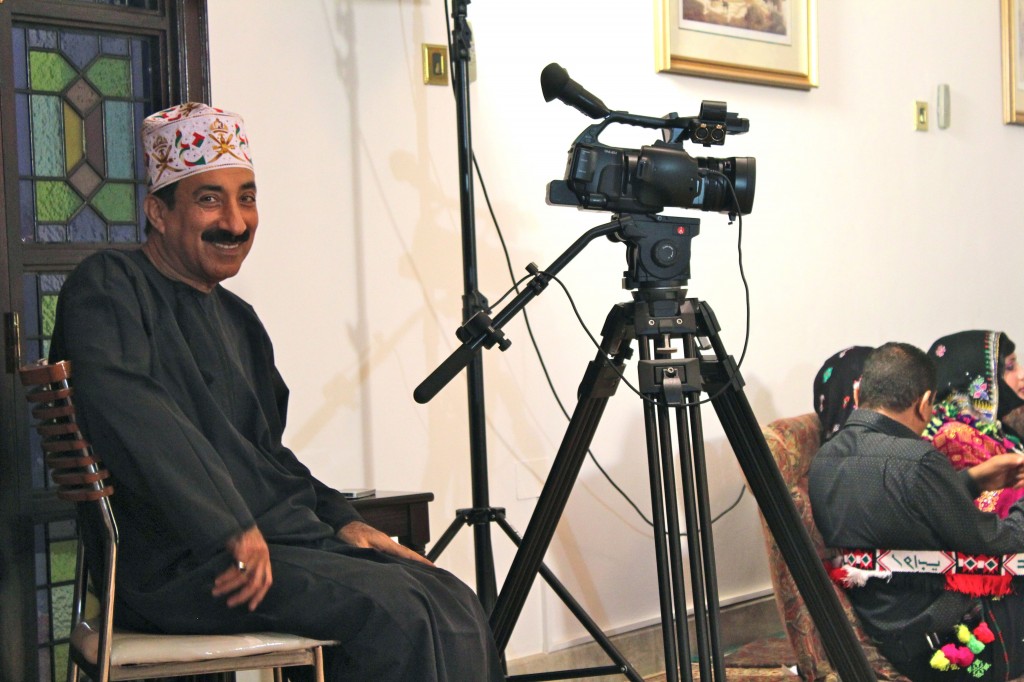
Since our chance meeting I have attended two events at Sheikh Ahmad’s and have had the opportunity to sit and chat with him about his life’s work, his views on music and culture in Oman, and his plans for the future.
Jalsa at-Tarab: The Private Listening Party
The word Jalsa comes from the Arabic verb “to sit” (the root is ja-la-sa, the Arabic letters, jim-lam-sin). In the musical sense a Jalsa is an event where a group of people who know each other well come together to drink tea, and chat, and listen to music. There is an expectation that camaraderie among the guests (sami‘a or listening connoisseurs) and between the guests and the musicians will be enhanced by the music itself. The term Jalsa is roughly analogous to the term Sahra (evening or private musical evening) a term introduced to me by musicians and patrons in the Arab American community in the 1980s. Both the Jalsa and the Sahra are distinct from the Haflah, a music event that is much larger, more public – even if all of the attendees are invited — and which borders on a concert, often with lively dancing, and sometimes with food. In fact here in Oman the term Haflah and concert have been used interchangeably.
Sheikh Ahmad’s Jalsa was consistent with my expectations. I arrived with my escort, Muhamad Al Nahari, the director of the regional office of the Ministry of Culture here in Salalah, who eased my way into this circle of elite music listeners. At both events I was the only woman present among the guests, with the exception of the female singers and dancers who were among the artists.
Al Mazyun was the group featured on the first evening. I had seen the group perform at the Mahrajan and had met its leader or Rais il-Firqa, Audh Said, who brought 17 musicians and dancers from Yemen to round out his troupe for the many performances they had scheduled for the Mahrajan season. Premier among the Yemeni performers is Salah Ahmad Rajeb a blind singer and ‘ud player and Qaisar Awad whose leadership of the group, even when he sits in the back row, is evident. Qaisar is a fabulous dancer and adds great dynamism to the “back row” of singers, clappers and exclaimers of “tashgia” or shouts of encouragement during performance.
Figure 2: Right to Left: ‘Audh Said, head of the Firqa Al Mazyun, Said Swilan, head of the stage, and Qiasar ‘Audh, one of the performers from Yemen, in front of the traditional house or Bait Turathi on the festival grounds.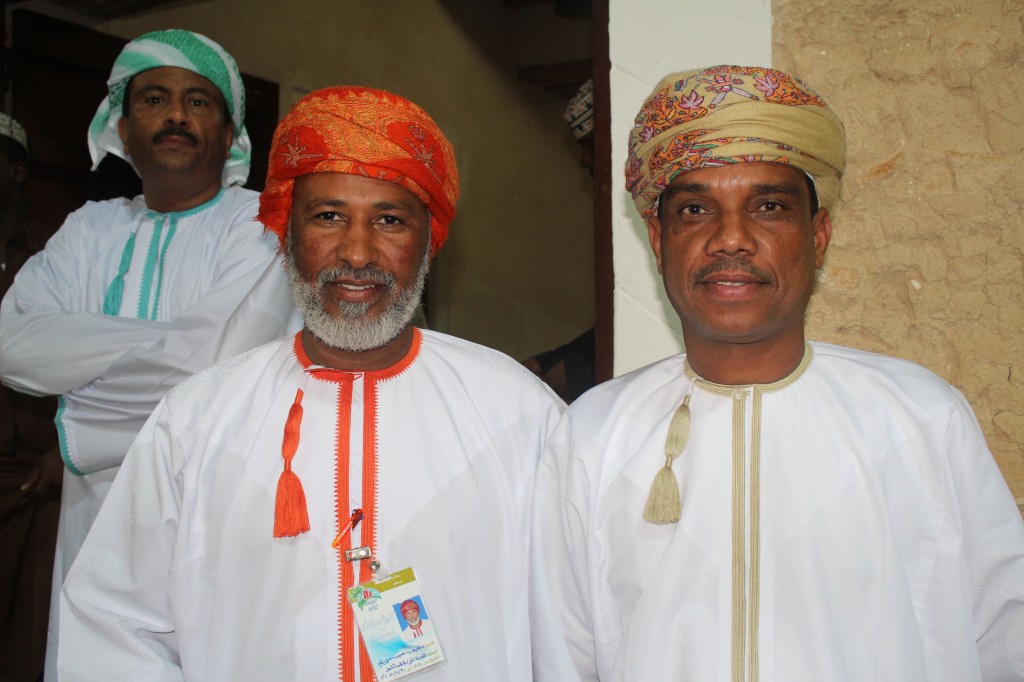
Figure 3: Sheikh Ahmad positions the microphone for Salah Ahmad Rajeb, singer and ‘ud player.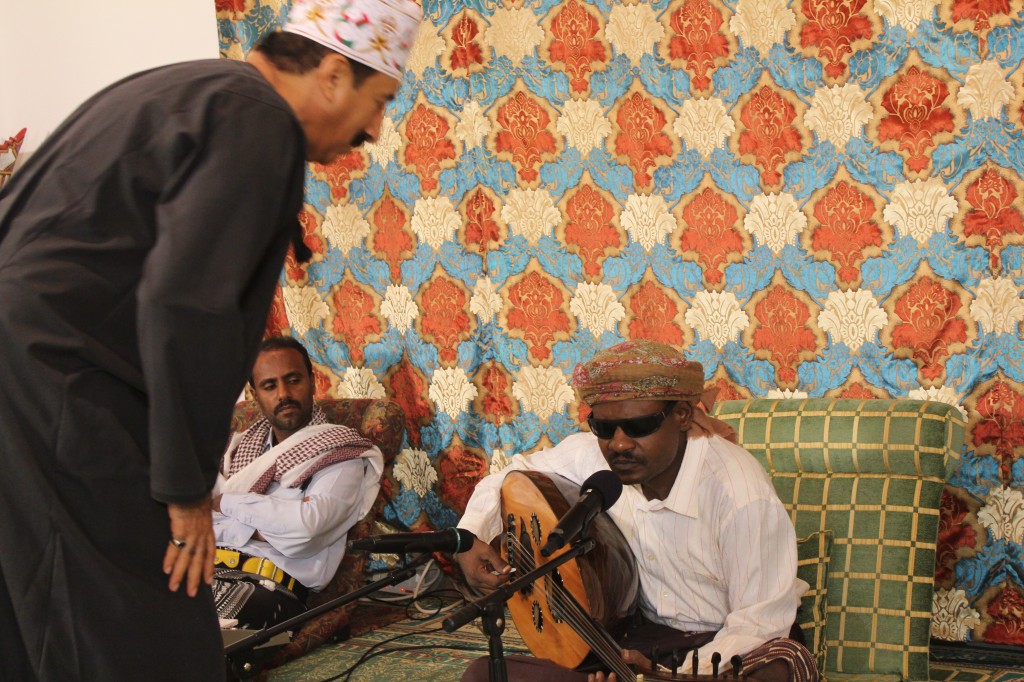
The ensemble, Al Mazyun performed the many styles of music and dance that I have learned are distinctive to Oman’s southern Dhofar province, genres and styles that are shared, with some variations, with the Southern region of Yemen. Salah began most of his songs with an ‘ud taqasim and mawwal, instrumental and vocal improvisations, respectively, that are more characteristic of the Arabic music from “balad ish-sham” or the northern Arab world countries of Syria, Iraq, Lebanon, and Egypt. A musician’s musician, Salah Ahmad Rajeb, added more than a touch of Arab multi-nationalism to the performance and helped to evoke an atmosphere of tarab (or shared musical ecstasy or enchantment) among the crowd. The dynamic dancing by women, and men, and women and men together, who typically arose mid-song to dance, embodied patterned choreography in ways that looked completely natural.
Yemen and Oman: Political and Cultural Boundaries
I had seen Al Mazyun perform on my first night at the Salalah Festival and it was pointed out to me then and in several subsequent instances that the presence of the Yemeni artists at the festival this year is contested. The reasons for this vary but the general sense is: this festival is supposed to present Omani music. When I question people here and in Muscat, both musicians and others in the business of culture, nearly everyone makes assertions about the importance of Yemen with statements like “Yemeni and Omani music are one and they same,” or “Everything comes from Yemen” or “All Arab culture started from Yemen.” In spite of official objections to Yemeni artists at the festival, there is a clear chorus that the Dhofar region, and especially the plains and coastal region of Salalah share much with Yemen, particularly Mahar, the Yemeni region that borders Dhofar in Oman, and Hadhramaut, the region to the West of Mahar. This is really one musical region albeit with distinctive variations. Providing evidence for the connection people cite similarity not only in musical styles and instruments, but also in dress, food, language, and even, the weather. And the connection is not just a historical one. A young man who sang and played the ‘ud at the end of the evening at Shiekh Ahmad’s said he had been to Yemen, “maybe two hundred times.” Recordings of Yemeni music are easily available in the record shops here in Salalah, and the borders between the two countries permit a regular flow of artists back and forth. Keeping the arts and culture of Yemen and Oman separate is largely a political exercise.
The Hajar: I found my drum!
My own interest in Yemeni music came into focus over the course of ten years of research on Indonesian Islamic because the Yemeni region of the Hadhramout is the historical and imaginary source of a great deal of Arab music and Islamic culture in the Southeast Asian archipelago. Traders from the Hadhramaut and generations of their ancestors played a major role in the transmission of Islam and the Arabization of Islamic culture in Indonesia. Continuing economic, cultural, and family ties are an indelible part of the relationship between the two nations. Yemen, through my work in Indonesia, was the reason I became interested in the Arabian Gulf, and why I eventually ended up doing research in the Sultanate of Oman. Of particular interest to me was a genre that is wildly popular in Indonesia today, called Hajar-Marawis, named after two drum types, the Hajar, a double-headed laced barrel drum and the small Mirwas, that produce interlocking complementary rhythms when played in pairs or in groups.
Figure 4: Jakarta, Indonesia, January 2010: The women’s Hajar Marawis group from the Institut Ilmu Al Qur’an play and sing at an exhibition of Islamic performing arts. The smaller drums are the Marawis. Front and center are two styles of Darabuka, played by the same person; just behind her another woman plays the double-headed Hajar drum with both hands.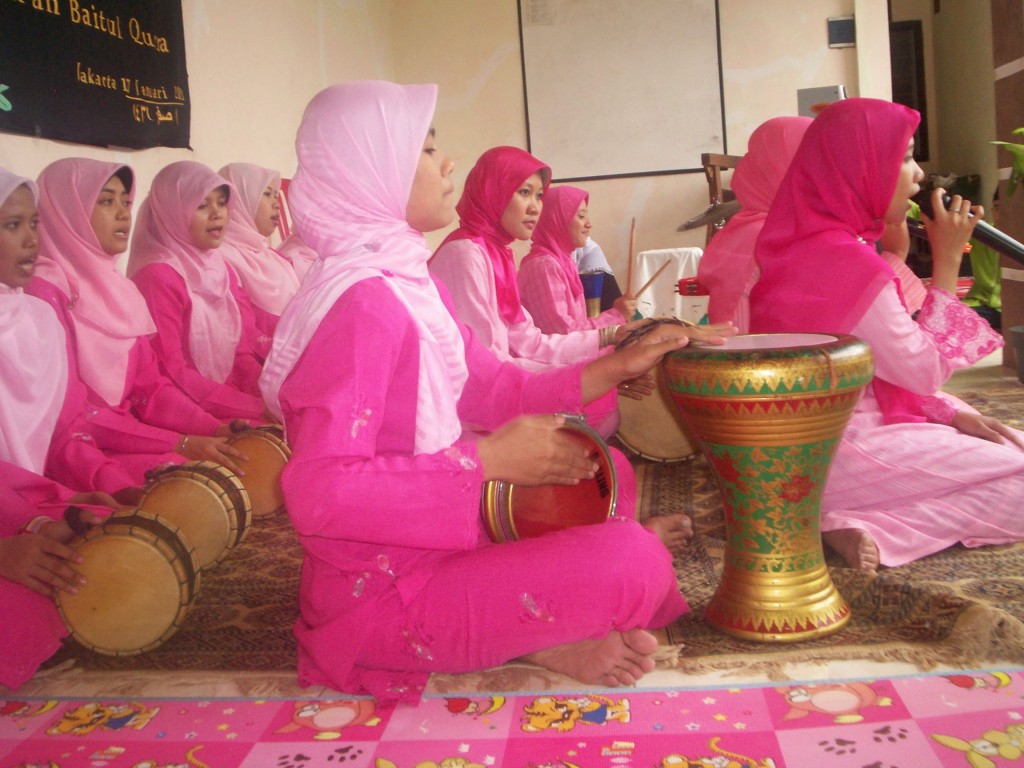
Marawis (plural) are plentiful in Oman, but the barrel drums that are prevalent here are the Rahmani and Kaser. Only one reference is made to the Mahjar drum (the term is obviously related to Hajar) in the Dictionary of Music in Oman originally compiled by the Egyptian musicologist Yusuf Showqi (1985-1987) in conjunction with his work for the Oman Center for Traditional Music and revised and republished by Dieter Christensen in 1994.
When I walked into large salon at Sheikh Ahmad’s that served as the stage for Al Mazyun and sized up the percussionists and their instruments my eyes lit up! I finally found my drum. Adil Mohamad confirmed that was indeed the Hajar.
Figure 5: At last, I found my drum! The Hajar (larger) and Mirwas (smaller) drums.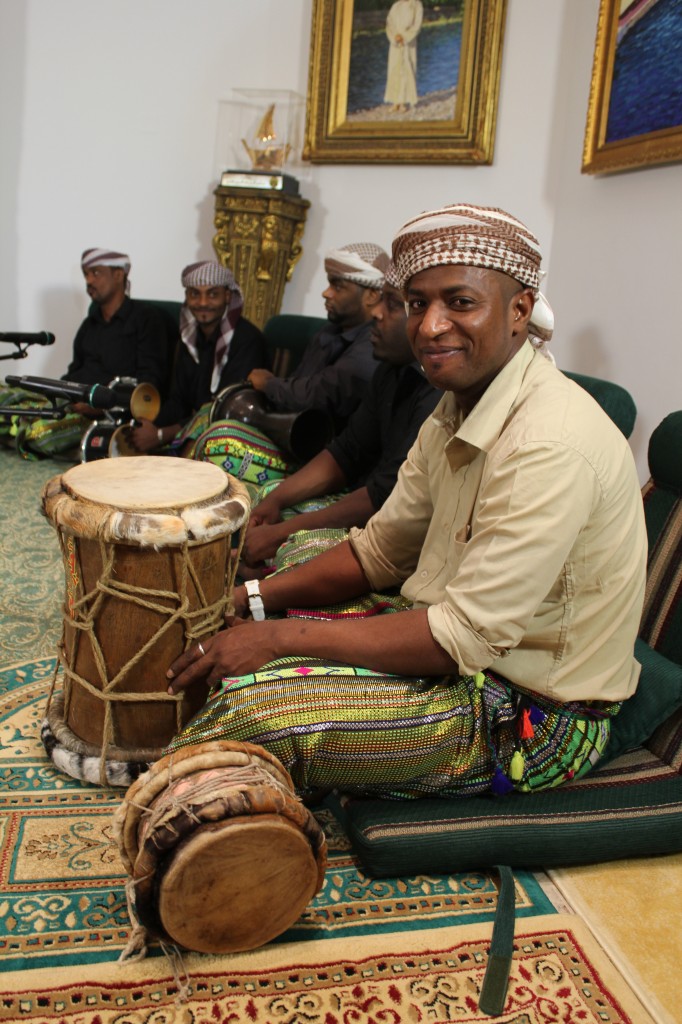
The Power of Patronage
Prior to the performance that evening and during the break and following a meal that was served at midnight to the musicians and guests (each eating separately on the floor but conversing with one another freely), Sheikh Ahmad played concert videos he had recorded over the years on a wide screen TV. Some of the people remembered events at which they had been present, others were anxious to hear singers and poets they knew well. Sheikh Ahmad showed me an even larger selection of his sharply edited performances when I joined him for tea one morning and explained the process involved. He and his team video their concerts with three cameras and record the sound separately. Sheik Ahmad edits the footage, using the sound from the audio recording, to produce a clean product with cutaways to shots of soloists and perhaps landscapes of nature, to create finished projects. Many of the events he has commissioned combine artists he would like to see together or provide new opportunities for musicians and poets to collaborate. On one occasion he invited a group that performs Malid, religious recitation, but asked them to prepare the poetry or Ibtihalat written by the most famous poet and singer from Salalah, Jam‘an Diwan, who composed a set of devotional verses upon his return from Medina. At both events it was clear that both the ensemble and the media team collaborated on the set list, which was written out in advance in one case, with requests from the Sheikh. Ahmad bin Suwaidan Al Balushi would like to open a private television station or at least a radio channel where he can play some “decent music” in Oman, something beyond the commercial and nationalist pop that dominates the sound waves here.
Figure 6: Dancers float across the floor in fast paced seemingly internalized choreography. Although the Dhofari and Yemeni dress, called thobe, both have the same pattern with the front hem of the dress about one foot shorter than the back hem, these women wear belts, an aspect of Yemeni women’s dress not seen in Oman.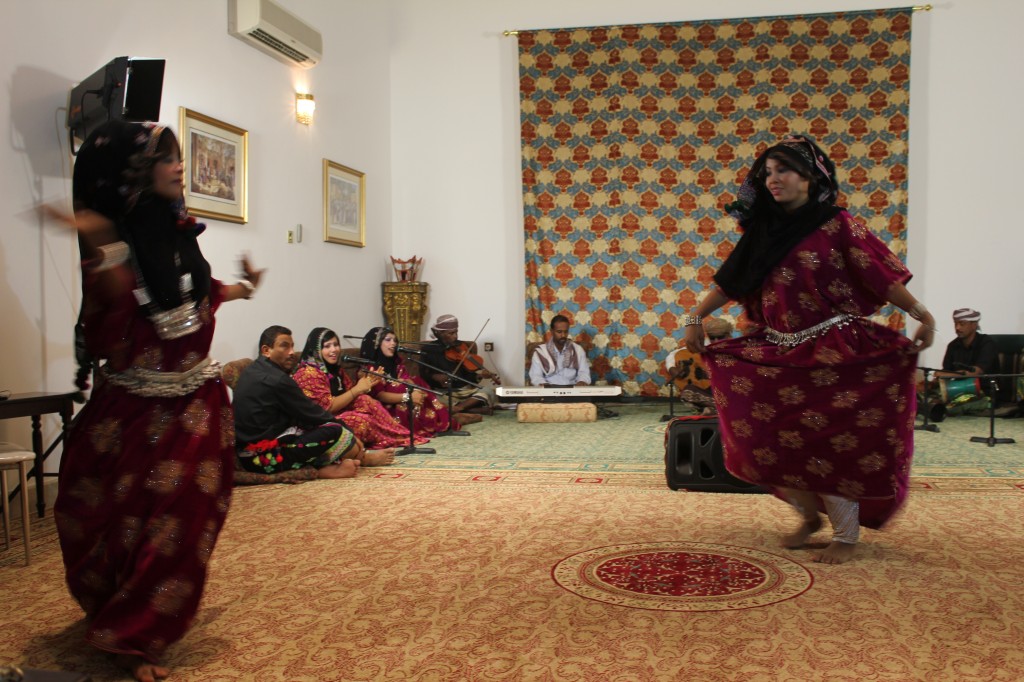
I told Sheikh Ahmad that I was surprised to find anything like this in Oman. Here in Salalah was a family of connoisseurs: Ahl al-Tarab, a term that denotes the association of musicians and patrons based on shared musical aesthetics and the social relationships and contextually situated behviours that are born from and facilitated by performance. What I had experienced in Oman were hyper-produced events, such as those surrounding National Day, or carefully scripted productions such as the opening concert for the Amateur ‘Ud Society in Muscat. Then, there is the traditional music that is played in festival settings, such as the performances I have described in Muscat and Salalah. The private concerts of the Sultanate’s premier ensembles, The Royal Oman Symphony Orchestra and the Sultan’s Arabic Orchestra (Firqa-t-is Sultaniyya Khas) take place within palace walls and the occasional concerts that happened at Al Bustan Palace, a 5 star hotel with a nice theater, are formal events with the protocol, pomp, circumstance, befitting of Muscat’s political elite and international ambassadorial and business community. And although I know THE place for music is the traditional wedding or other family celebration, it just didn’t seem as though the people I met in Oman were really involved in music except as infrequent consumers.
“Yes, but we are in Salalah,” Sheikh Ahmad said with a twinkle in his eye, “and here we are close to the culture of Yemen.”
Sheikh Ahmad, with his unconditional love for music and camaraderie and his passion for documentation and production is an extraordinary force, operating under the official radar of cultural production in the Sultanate. His life’s work in telecommunications as it has been applied to commissioning and archiving hundreds of performances of music and dance is his legacy, which, one hopes, will become accessible to all of the Ahl at-Tarab of present and future generations.
AKR
Comments are currently closed. Comments are closed on all posts older than one year, and for those in our archive.

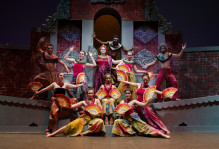
OMG, I love your blog! I feel as though I am there (will be as close as I ever get) I do wonder why no women were in attendance when you went to the evening presentation other than the musicians and the dancers. Keep up the good work and know that one friend here is thoroughly enjoying each and every one.
Hi Anne. Great blog! I’m enjoying reading it and look forward to future entries. I don’t know much about that area and hope to visit at some point. How nice to find yourself among “ahl al-tarab”! ‘aziim!
salamaat,Jonathan
Congratulations Anne ~ this is an extraordinary glimpse into so many interconnecting elements. Breathtaking!
Looking forward to drumming with you!
Rowan
Fabulous blog – thank you for sharing your adventures, Anne!
Anne,I am so thanksful for sharing with us all of your experiences with the Arabic culture and people. My husband is from Arabic descent and I am so in love with that culture and language!You enriched me with the quotd saying”“A chance meeting is worth a thousand appointments” which I am going to remember! I have not been able to discover fully yet, the immense beauty of the Arabic music, neither the areas of Southern Oman and Yemen as a musical regions, but you inspired me so much! Thanks, Anne and please, keep us posted!